Albanien |
|
|
|
| Übersicht – Contents: | |
Diese Seite ist Teil des Projektes
Albanien |
|
|
|
| Übersicht – Contents: | |
Flaggen – Flags: |
|
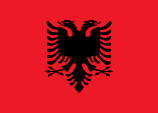 |
seit/since 1992, Nationalflagge – national flag, Seitenverhältnis – ratio = 5:7, Quelle/Source nach/by: Wikipedia (D) |
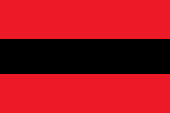 |
Handelsflagge – merchant flag, Seitenverhältnis – ratio = 2:3, Quelle/Source nach/by: Flags of all Nations |
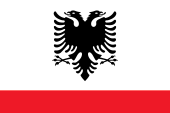 |
Marineflagge – naval flag, Seitenverhältnis – ratio = 2:3, Quelle/Source nach/by: Flags of all Nations |
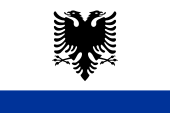 |
Flagge der Hilfsschiffe (Seedienstflagge) – flag for auxiliary ships (official flag at sea), Seitenverhältnis – ratio = 2:3, Quelle/Source nach/by: Wikipedia (D) |
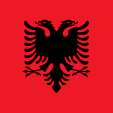 |
Flagge des Präsidenten – flag of the president, Quelle/Source nach/by: Wikipedia (D) |
historische Flaggen – historical Flags: |
|
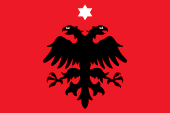 |
1912–1913, Nationalflagge – national flag, Quelle/Source nach/by: Flags of the World |
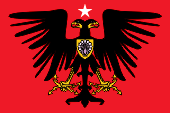 |
1914, Fürstentum Albanien – Principality of Albania, Nationalflagge – national flag, Quelle/Source nach/by: Flags of the World |
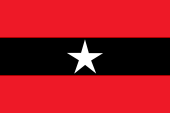 |
1914, Fürstentum Albanien – Principality of Albania, Handelsflagge – merchant flag, Quelle/Source nach/by: Flags of the World |
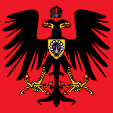 |
1914, Fürstentum Albanien – Principality of Albania, Standarte von Wilhelm Prinz zu Wied, Fürst von Albanien – Standard of William Prince of Wied, Prince of Albania, Quelle/Source nach/by: Flags of the World |
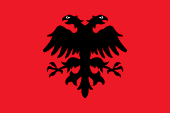 |
1914–1920, Nationalflagge – national flag, Quelle/Source nach/by: Flags of the World |
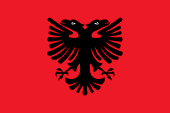 |
1920–1928, Republik Albanien – Republic of Albania, National-, Marine und Kriegsflagge – national, naval and war flag, Quelle/Source nach/by: Flags of the World |
 |
1920–1928, Republik Albanien – Republic of Albania, Handelsflagge – merchant flag, Quelle/Source nach/by: Flags of the World |
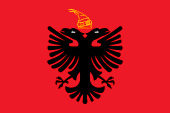 |
1920–1928, Republik Albanien – Republic of Albania, Flagge des Präsidenten – flag of the president, Quelle/Source nach/by: Flags of the World |
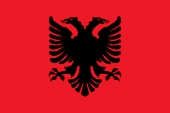 |
1928–1939, Königreich Albanien – Kingdom of Albania, Nationalflagge – national flag, Quelle/Source nach/by: Flags of the World |
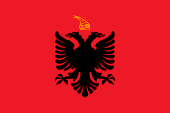 |
1928–1939, Königreich Albanien – Kingdom of Albania, Staatsflagge – state flag, Quelle/Source nach/by: Flags of the World |
 |
1928–1939, Königreich Albanien – Kingdom of Albania, Handelsflagge – merchant flag, Quelle/Source nach/by: Flags of the World |
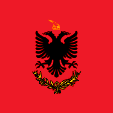 |
1928–1939, Königreich Albanien – Kingdom of Albania, Flagge des Königs – flag of the king, Quelle/Source nach/by: Flags of the World |
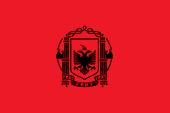 |
1939–1943, Königreich Albanien – Kingdom of Albania, Nationalflagge – national flag, Quelle/Source nach/by: Flags of the World, F l a n k e r, Public domain, via Wikimedia Commons |
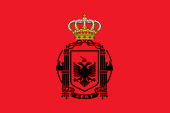 |
1939–1943, Königreich Albanien – Kingdom of Albania, Staatsflagge – state flag, Quelle/Source nach/by: Flags of the World, F l a n k e r, Public domain, via Wikimedia Commons |
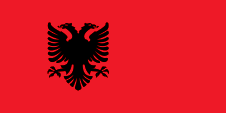 |
1943–1944, Nationalflagge – national flag, Seitenverhältnis – ratio = 1:2, Quelle/Source nach/by: Flags of the World |
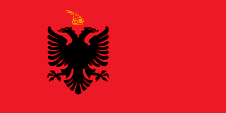 |
1943–1944, Staatsflagge – state flag, Seitenverhältnis – ratio = 1:2, Quelle/Source nach/by: Flags of the World |
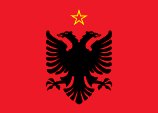 |
1946–1992, Sozialistische Volksrepublik Albanien – Socialist People's Republic of Albania, Nationalflagge – national flag, Seitenverhältnis – ratio = 5:7, Quelle/Source nach/by: Flags of the World |
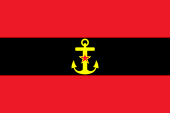 |
1946-1954, Sozialistische Volksrepublik Albanien – Socialist People's Republic of Albania, Marineflagge – naval flag, Seitenverhältnis – ratio = 2:3, Quelle/Source nach/by: Flags of the World |
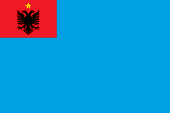 |
1954-1958, Sozialistische Volksrepublik Albanien – Socialist People's Republic of Albania, Marineflagge – naval flag, Seitenverhältnis – ratio = 2:3, Quelle/Source nach/by: Flags of the World |
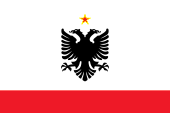 |
1958-1992, Sozialistische Volksrepublik Albanien – Socialist People's Republic of Albania, Marineflagge – naval flag, Seitenverhältnis – ratio = 2:3, Quelle/Source nach/by: Flags of the World |
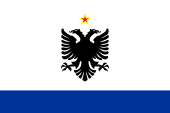 |
1958-1992, Sozialistische Volksrepublik Albanien – Socialist People's Republic of Albania, Flagge der Hilfsschiffe – flag for aux ships, Seitenverhältnis – ratio = 2:3, Quelle/Source nach/by: Flags of the World |
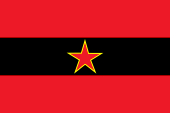 |
1946–1992, Sozialistische Volksrepublik Albanien – Socialist People's Republic of Albania, Handelsflagge – merchant flag, Seitenverhältnis – ratio = 2:3, Quelle/Source nach/by: Flags of the World |
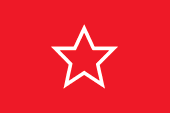 |
1958–1992, Sozialistische Volksrepublik Albanien – Socialist People's Republic of Albania, Gösch – jack, Seitenverhältnis – ratio = 2:3, Quelle/Source nach/by: Flags of the World |
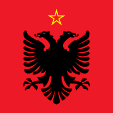 |
1946–1992, Sozialistische Volksrepublik Albanien – Socialist People's Republic of Albania, Flagge des Präsidenten – flag of the president, Quelle/Source nach/by: Flags of the World |
Bedeutung/Ursprung der Flagge – Meaning/Origin of the Flag: |
|
| Die Flagge Albaniens geht unmittelbar auf den Nationalhelden Skanderbeg zurück. Er war adliger Herkunft, und hieß eigentlich Georg Kastriota. Er führte einen antitürkischen Aufstand zwischen den Jahren 1443 und 1468 an, nachdem das sich immer mehr ausbreitende Osmanische Reich seit 1385 das byzantinische Restgebiet Epirus niederrang, und damit das Gebiet des heutigen Albanien zu unterwerfen begann. Während des Aufstandes benutze Skanderbeg rote Flaggen mit einem schwarzen doppelköpfigem Adler. Wahrscheinlich wurde Skanderbeg von der byzantinischen Flagge inspiriert. Angeblich soll auch die Legende, dass die Albaner Nachkommen der Adler wären, eine Rolle gespielt haben. | The flag
of Albania goes directly back to the national hero Skanderbeg. He was of
origin, and was named really George Kastriota. He led an anti-Turkish revolt
between the years 1443 and 1468, after the ever further expanding Ottoman
Empire since 1385 had wrestled down Epirus, the remaining rump territory of
Byzantium, the Empire began to subdue the territory of today's Albania.
During the revolt Skanderbeg used red flags with a black double-headed eagle. He was probably Skanderbeg inspired by the Byzantine flag. Ostensibly, the legend that the Albanians are descendants of eagles, might also have played a role. |
| Nach der Erklärung der Unabhängigkeit vom Osmanischen Reich am 28.11.1912, besann man sich auf die alte Flagge, und es wurde eine rote Flagge eingeführt, mit einem schwarzen zweiköpfigen Adler und einem sechszackigen Stern darüber. Der Stern sollte die Albaner daran erinnern, dass sie, ganz gleich welche Religion sie haben, den gleichen Sternenhimmel über den Köpfen haben. Als der deutsche Prinz Wilhelm zu Wied im Jahr 1914 Fürst von Albanien wurde, hat man die Flagge ein wenig verändert, denn da zum albanischen Territorium nun ein Teil des alten Epirus gehörte, wurden die dieses Land verkörpernden je vier goldenen Blitze in die Klauen des Adlers ergänzt. Als am 01.09.1928 Ahmed Zogu albanischer König wurde, hat er eine Änderung der Flagge veranlasst: Der goldene Helm Skanderbegs wurde in die Staatsflagge aufgenommen. Als Italien 1939 Albanien besetzte, wurde die Flagge Albaniens wieder verändert: Die albanische Krone wurde zum Adler ergänzt, ebenso wie zwei schwarze Liktorenbündel. | After the
declaration of independence from the Ottoman Empire on the 28th of November,
1912, they remember the old flag, and introduced a red flag, with a black
two-headed eagle and a six-pointed star above. The star was to be a reminder for Albanians, that they have the same firmament above their heads regardless to which religion they may belong. When the German Prince Wilhelm zu Wied became Prince of Albania, the flag was changed a little, because a part of the old Epirus now belonged to Albania, the four golden lightning bolts in the claws of the eagle representing Epirus were incorporated. When on the 1st of September, 1928 Ahmed Zogu became Albanian King, he caused a changing of the flag: the golden helmet of Skanderbeg was placed on the state flag. When Italy occupied in 1939 Albania, the flag of Albania was changed again: The Albanian crown was added to the eagle and two bundles of black Fasces (the Roman symbol for the authority of the Lictors). |
| Der anti-italienische Widerstand, unter kommunistischer Führung, führte ebenfalls die rote Flagge mit dem Adler, bei der sich jedoch ein gelb umrandeter fünfzackiger Stern oberhalb des Adlers befand. Diese Flagge wurde offiziell am 15.03.1946 im Zusammenhang mit der Gründung der Volksrepublik eingeführt. Mit dem Rücktritt des letzten kommunistischen Präsidenten wurde der Stern am 07.04.1992 wieder von der Flagge entfernt. | Likewise,
the anti-Italian resistance, under communist leadership, used the red flag
with the eagle, with a yellow five-pointed star above its heads. This flag was officially introduced on the 15th of March, 1946 in connexion with the founding of the people's republic. With the resignation of the last communist president the star was deleted from the flag on the 7th of April, 1992. |
|
Quelle/Source:
Die Welt der Flaggen,
Flaggen und Wappen der Welt Translator of the English text: Joachim Nuthack |
|
Wappen – Coat of Arms: |
|
 |
seit/since 1993, Wappen von Albanien – coat of arms of Albania, Quelle/Source nach/by: Wikipedia (D), Government of Albania, Public domain, via Wikimedia Commons |
historische Wappen – historical coats of arms: |
|
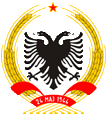 |
1946–1992, Wappen von Albanien – coat of arms of Albania, Quelle/Source nach/by: Flaggen und Wappen der Welt |
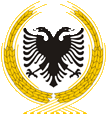 |
1992–1993, Wappen von Albanien – coat of arms of Albania, Quelle/Source nach/by: Flaggen und Wappen der Welt |
Bedeutung/Ursprung des Wappens – Meaning/Origin of the Coat of Arms: |
|
| Im Zusammenhang mit der Gründung der Volksrepublik (1946) wurde auch ein anderes Wappen eingeführt. Der Adler wurde von Ähren umgeben, und oberhalb des Adlers befand sich, wie bei der Flagge, ein roter, gelb umrandeter fünfzackiger Stern. Die Ähren waren mit einem roten Band verbunden, welches das Datum – 24. Mai 1944 – enthielt. An diesem Tag wurde in Permeti ein sogenannter "antifaschistischer Befreiungsausschuss" gebildet. Am 07.04.1992 wurden zunächst nur das Band mit dem Datum und der Stern entfernt, und ab dem 22.05.1993 wurde der schwarze zweiköpfige Adler in einem rotem Schild benutzt. Seit 2004 erscheint oberhalb des Adlers der goldene Helm Skanderbegs. | In
connexion with the founding of the people's republic (1946) different coat
of arms was also introduced. The eagle was surrounded by ears of grain, and
above the eagle was placed, as on the flag, a red yellow-bordered
five-pointed star. The ears of grain were bound with a red ribbon, which
contained the date 24th of May, 1944. On this date a so-called
"anti-faschist liberation committee" was formed in Permeti. On the 7th of April, 1992 the ribbon with the date and the star was initially removed, however, since the 22nd of May, 1993 the black twin-headed eagle in a red shield was in use. Since 2004 appears above the eagle the golden helmet of Skanderbeg. |
|
Quelle/Source:
Flaggen und Wappen der Welt Translator of the English text: Joachim Nuthack |
|
Flugzeugkokarde – aircraft roundel: |
|
 |
1962–1992, Flugzeugkokarde – aircraft roundel Quelle/Source: nach/by Wikipedia (EN) |
 |
seit/since 1992, Flugzeugkokarde – aircraft roundel Quelle/Source: nach/by Wikipedia (EN) |
| Landkarten – Maps: |
Lage – Position: |
Landkarte des Landes – Map of the Country: |
Zahlen und Fakten – Numbers and Facts: |
|
|
|
|
|
|
|
|
|
|
|
|
|
|
|
|
|
|
|
|
|
|
Geschichte: |
||||||||
|
380 v.Chr. bis 168 v.Chr. · Reich illyrischen Labeaten 395 n.Chr. · bei der Teilung des Römischen Reiches kommt das heutige Albanien an das Oströmische Reich (Byzanz) 591 · Slaweninvasion 880–1018 · Mittel- und Südalbanien sind Teil des Bulgarischen Reiches 1081 · Normanneninvasion 1204–1430 · vom Ende des 4. Kreuzzuges (Zerfall des Byzantinischen Reiches), geraten Teile des Landes an Neapel, Serbien und Venedig und es bilden sich lokale albanische Fürstentümer heraus (Kruja, Thopias, Balscha) 1430 · Angriffe der Türken 1443–1468 · erfolgreicher Abwehrkampf des Fürsten Georg Kastriota Skanderbeg gegen die Türken 1479 · das Land kommt zum Osmanischen Reich 1910 · Antitürkischer Aufstand, das Osmanische Reich hält nur noch die großen Städte besetzt 28.11.1912 · Unabhängigkeit als Republik Albanien 21.02.1914 · die Führer der oft zerstrittenen albanischen Volks- und Religionsgruppen bieten Wilhelm Prinz zu Wied in Neuwied die albanische Krone an, er wird als Wilhelm I. Fürst von Albanien, die Großmächte sagen Unterstützung zu März–August 1914 · Wilhelm I. kommt durch Aufstände der Griechen, Moslems und lokaler Herrscher unter Druck, die Großmächte leisten keine Unterstützung 03.09.1914 · Wilhelm I. emigriert nach Rumänien, dankt jedoch niemals ab, das Land wird während des Ersten Weltkriegs von ausländischen Mächten besetzt, die Republik Albanien besteht nominell weiter, Italien, Serbien und Griechenland besetzen und beanspruchen bis 1920 Teile des Landes für sich 1917 · Wilhelm I. verlangt seine Wiedereinsetzung 1919 · Verhandlungen über die Aufteilung des Landes Januar 1920 · Albanischer Kongress von Lushnja, Absetzung der Regierung von Turhan Pascha, Neuwahl einer Regierung unter Sulejman Delvina, die international schnell anerkannt wird, die Besatzungsmächte ziehen sich zurück Dezember 1920 · Aufnahme Albaniens in den Völkerbund 1925 · autoritäre Herrschaft von Ahmet Zogu 1928 · Ahmet Zogu proklamiert sich selbst zum König, das nunmehrige Königreich Albanien wird in den Folgejahren zunehmend von Italien abhängig 1939 · Zweiter Weltkrieg, Italien besetzt das Land, Viktor Emanuel König von Italien wird in Personalunion als König von Albanien eingesetzt, Ahmet Zogu flieht, in den Folgejahren etabliert und verstärkt sich ein von Kommunisten dominierter Widerstand 08.09.1943 · Italien kapituliert, deutsche Truppen besetzen das Land 24.05.1944 · Kongress von Përmet, Bildung eine provisorischen kommunistischen Regierung 29.11.1944 · die deutsche Truppen verlassen das Land 11.01.1946 · Proklamation der Volksrepublik Albanien 14.05.1955 · Betritt zum Warschauer Pakt (1968 Austritt) 14.12.1955 · Aufnahme in die Vereinten Nationen (UNO) 28.12.1976 · neue Verfassung, Umbenennung in Sozialistische Volksrepublik Albanien Herbst 1990 · Antikommunistische Bewegung 31.03.1991 · Wahlen, die kommunistische Regierung wird bestätigt 04.06.1991 · Generalstreik, Rücktritt der kommunistischen Regierung, Bildung einer Regierung der nationalen Einheit, Umbenennung in Republik Albanien 09.07.2009 · Betritt zur NATO
|
History:
380 B.C. to 168 B.C. · Empire of the Illyrian Labeates | 395 A.D. · when the Roman Empire is divided, today's Albania comes to the Eastern Roman Empire (Byzantium) 591 · Slav invasion 880–1018 · central and southern Albania are part of the Bulgarian Empire 1081 · Norman Invasion 1204–1430 · from the end of the 4th Crusade (collapse of the Byzantine Empire), parts of the country come to Naples, Serbia and Venice and local Albanian principalities emerge (Kruja, Thopias, Balscha) 1430 · Attacks by the Turks 1443–1468 · Prince Georg Kastriota Skanderbeg's successful defensive battle against the Turks 1479 · the country becomes part of the Ottoman Empire 1910 · Anti-Turkish uprising, only the big cities are under control of the Ottoman Empire 28th of November 1912 · independence as the Republic of Albania 21st of February in 1914 · the leaders of the often divided Albanian ethnic and religious groups offer Wilhelm Prinz zu Wied in Neuwied (Rhineland) the Albanian crown, he becomes Prince Wilhelm I. of Albania, the great powers promise support March to August 1914 · Wilhelm I. comes under pressure from revolts by the Greeks, Muslims and local rulers, the great powers do not provide any support 3rd of September 1914 · Wilhelm I. emigrates to Romania, but never abdicates, the country is occupied by foreign powers during the First World War, the nominal republic of Albania continues to exist, Italy, Serbia and Greece occupy and claim parts of the country for themselves until 1920 1917 · Wilhelm I. demands his reinstatement 1919 · negotiations on the division of the land January 1920 · Albanian Congress of Lushnja, deposition of the government of Turhan Pascha, new election of a government under Sulejman Delvina, which is quickly recognized internationally, the occupying powers withdraw December 1920 · joining to the League of Nations 1925 · authoritarian reign of Ahmet Zogu 1928 · Ahmet Zogu proclaims himself king, the now Kingdom of Albania becomes increasingly dependent from Italy in the following years 1939 · Second World War, Italy occupies the country, Victor Emanuel, King of Italy, is installed as King of Albania in personal union, Ahmet Zogu flees, in the following years establishes and increases a by communists dominated resistance 8th of September in 1943 · Italy surrenders, German troops occupy the country 24th of May in 1944 · Congress of Përmet, formation of a provisional communist government 29th of November in 1944 · the German troops leave the country 11th of January in 1946 · proclamation of the People's Republic of Albania 14th of May in 1955 · joining to the Warsaw Pact (left in 1968) 14th of December in 1955 · joining to the United Nations (UN) 28th of December in 1976 · new constitution, rename in Socialist People's Republic of Albania Fall 1990 · anti-communist movement 31st of March in 1991 · elections, the communist government is confirmed 4th of June in 1991 · general strike, resignation of the communist government, formation of a government of national unity, rename in Republic of Albania 9th of July in 2009 · joining to the NATO
Quelle/Source:
Atlas zur Geschichte,
Wikipedia (D),
Länder der Erde |
|
Ursprung des Landesnamens – Origin of the Country's Name: |
|
| Der Name "Albanien" geht auf das indogermanische Wort "alb" → "hoch, bzw. Berg" zurück, das sich später noch mit der Bedeutung des lateinischen Wortes "albus" → "weiß" verbunden hat. Albanien ist das "Hochland". Die Albaner (Eigenbezeichnung: Schiptar) nennen ihr Land "Schiperija" oder "Schiptarije". | The name
Albania has its roots in the Indogerman word "alb" → "high, or mountain",
which later had been merged with the meaning of the Latin word "albus" →
"white". Albania is the "Highlands". The Albanians (native name: Shiptar)
call their country "Shiperija" or "Shiptarije. |
| Quelle/Source: Handbuch der geographischen Namen | |